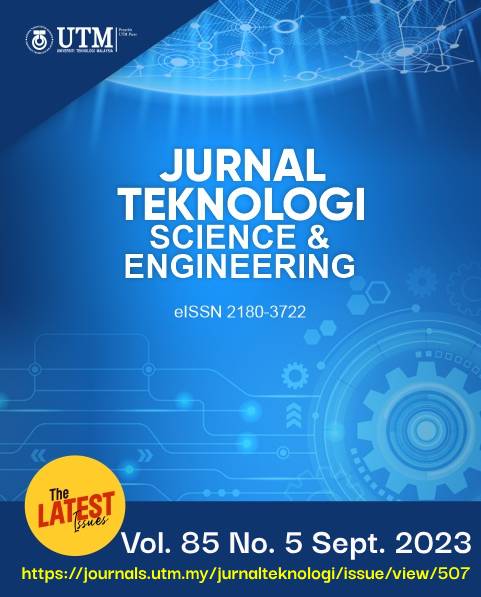CFD SIMULATION AND VALIDATION FOR MIXING VENTILATION SCALED-DOWN EMPTY AIRCRAFT CABIN USING OPENFOAM
DOI:
https://doi.org/10.11113/jurnalteknologi.v85.19423Keywords:
CFD, OpenFOAM, aircraft cabin, mixing ventilation, validationAbstract
An investigation into the spread of the COVID-19 virus within a confined space including an aircraft cabin is essential in order to find out the mechanism. However, this is time-consuming and limited in scope, so a computational fluid dynamics (CFD) simulation is used instead. Therefore, a prior study and an appropriate choice of turbulence model are required before the simulation. The main objective of this study is to validate and evaluate the results predicted by the Open Source Field Operation and Manipulation (OpenFOAM) software through comparison with the experimental data from the literature which was conducted using particle image velocimetry (PIV) measurement. Three different Reynolds-averaged Navier-Stokes turbulence models were selected; Re-normalisation Group k - ɛ (RNG), Realizable k - ɛ (RLZ) and Low Reynold Number (LRN) to simulate a mixing ventilation system of a scaled-down model of empty aircraft cabin. In the RNG and LRN model cases, a fairly large circulation flows were observed on the right and left sides of the model representing the passenger area. The results were also evaluated quantitatively using the factor of two of observations (FAC2) for the velocity components and turbulent kinetic energy (TKE) with root mean square error (RMSE) for the former and normalised mean square errors (NMSE) for the latter. The simulation results showed that RNG and LRN are capable of predicting the flow field well. However, for TKE prediction LRN performed better than RNG which concluded that LRN is the suitable turbulence model in simulating flow fields in investigated case.
References
2019. ASHRAE Handbook: HVAC Applications-Chapter 13-Aircraft. Atlanta: ASHRAE.
Li, J., Cao, X., Liu, J., Wang, C. and Zhang, Y. 2015. Global Airflow Field Distribution in a Cabin Mock-up Measured Via Large-scale 2D-PIV. Building and Environment. 93: 234-244.
Doi: https://doi.org/10.1016/j.buildenv.2015.06.030.
Liu, M., Liu, J., Cao, Q., Li, X., Liu, S., Ji, S., Lin, C.H., Wei, D., Shen, X., Long, Z. and Chen, Q. 2022. Evaluation of Different Air Distribution Systems in a Commercial Airliner Cabin in Terms of Comfort and COVID-19 Infection Risk. Building and Environment. 208: 108590.
Doi: https://doi.org/10.1016/j.buildenv.2021.108590.
Li, X., Zhang, T. T., Fan, M., Liu, M., Chang, D., Wei, Z. D., Lin, C. H., Ji, S., Liu, J., Shen, S. and Long, Z. 2021. Experimental Evaluation of Particle Exposure at Different Seats in a Single-aisle Aircraft Cabin. Building and Environment. 202: 108049.
Doi: https://doi.org/10.1016/j.buildenv.2021.108049.
Liu, W., Wen, J., Lin, C.H., Liu, J., Long, Z. and Chen, Q. 2013. Evaluation of Various Categories of Turbulence Models for Predicting Air Distribution in an Airliner Cabin. Building and Environment. 65: 118-131.
Doi: https://doi.org/10.1016/j.buildenv.2013.03.018.
Mazumdar, S. and Chen, Q. 2008. Influence of Cabin Conditions on Placement and Response of Contaminant Detection Sensors in a Commercial Aircraft. Journal of Environmental Monitoring. 10(1): 71-81.
Doi: https://doi.org/10.1039/b713187a.
Cao, Q., Liu, M., Li, X., Lin, C.H., Wei, D., Ji, S., Zhang, T. T. and Chen, Q. 2022. Influencing Factors in the Simulation of Airflow and Particle Transportation in Aircraft Cabins by CFD. Building and Environment. 207: 108413.
Doi: https://doi.org/10.1016/j.buildenv.2021.108413.
Yang, C., Zhang, X., Cao, X., Liu, J. and He, F. 2015. Numerical Simulations of the Instantaneous Flow Fields in a Generic Aircraft Cabin with Various Categories Turbulence Models. Procedia Engineering. 121: 1827-1835.
Doi: https://doi.org/10.1016/j.buildenv.2015.10.022.
You, R., Lin, C. H., Wei, D. and Chen, Q. 2019. Evaluating the Commercial Airliner Cabin Environment with Different Air Distribution Systems. Indoor Air. 29(5): 840-853.
Doi: https://doi.org/10.1111/ina.12578.
Zhao, Y., Liu, Z., Li, X., Zhao, M. and Liu, Y. 2020, June. A Modified Turbulence Model for Simulating Airflow Aircraft Cabin Environment with Mixed Convection. Building Simulation. 13(3): 665-675.
Doi: https://doi.org/10.1007/s12273-020-0609-2.
Desai, P. S., Sawant, N. and Keene, A. 2021, December. On COVID-19-safety Ranking of Seats in Intercontinental Commercial Aircrafts: A Preliminary Multiphysics Computational Perspective. Building Simulation. 14(6): 1585-1596.
Doi: https://doi.org/10.1007/s12273-021-0774-y.
Thysen, J. H., van Hooff, T., Blocken, B. and van Heijst, G. 2022. PIV Measurements of Opposing-jet Ventilation Flow in a Reduced-scale Simplified Empty Airplane Cabin. European Journal of Mechanics-B/Fluids. 94: 212-227.
Doi: https://doi.org/10.1016/j.euromechflu.2022.03.001.
Bell, J. H. and Mehta, R. D. 1988. Contraction Design for Small Low-speed Wind Tunnels (No. NASA-CR-177488).
Doi: https://ntrs.nasa.gov/citations/19890004382.
Brassard, D. and Ferchichi, M. 2005. Transformation of a Polynomial for a Contraction Wall Profile. J. Fluids Eng. 127(1): 183-185.
Doi: https://doi.org/10.1115/1.1852492.
Li, M., Yan, Y., Zhao, B., Tu, J., Liu, J., Li, F. and Wang, C. 2018. Assessment of Turbulence Models and Air Supply Opening Models for CFD Modelling of Airflow and Gaseous Contaminant Distributions in Aircraft Cabins. Indoor and Built Environment. 27(5): 606-621.
Doi: https://doi.org/10.1177/1420326X16688049.
Launder, B. E. and Sharma, B. I. 1974. Application of the Energy-dissipation Model of Turbulence to the Calculation of Flow Near a Spinning Disc. Letters in Heat and Mass Transfer. 1(2): 131-137.
Doi: https://doi.org/10.1016/0094-4548(74)90150-7.
Thysen, J. H., van Hooff, T., Blocken, B. and van Heijst, G. J. F. 2021. CFD Simulations of Two Opposing Plane Wall Jets in a Generic Empty Airplane Cabin: Comparison of RANS and LES. Building and Environment. 205: 108174.
Doi: https://doi.org/10.1016/j.buildenv.2021.108174.
Roache, P. J. 1997. Quantification of Uncertainty in Computational Fluid Dynamics. Annual Review of Fluid Mechanics. 29(1): 123-160.
Doi: https://doi.org/10.1146/annurev.fluid.29.1.123.
Zhang, Y., Liu, J., Pei, J., Li, J. and Wang, C. 2017. Performance Evaluation of Different Air Distribution Systems in an Aircraft Cabin Mockup. Aerospace Science and Technology. 70: 359-366.
Doi: https://doi.org/10.1016/j.ast.2017.08.009.
W. F. M. 2020. The Effects of Various Opening Sizes and Configurations to Air Flow Dispersion and Velocity in Cross-ventilated Building. Jurnal Teknologi. 82(4).
Downloads
Published
Issue
Section
License
Copyright of articles that appear in Jurnal Teknologi belongs exclusively to Penerbit Universiti Teknologi Malaysia (Penerbit UTM Press). This copyright covers the rights to reproduce the article, including reprints, electronic reproductions, or any other reproductions of similar nature.
















